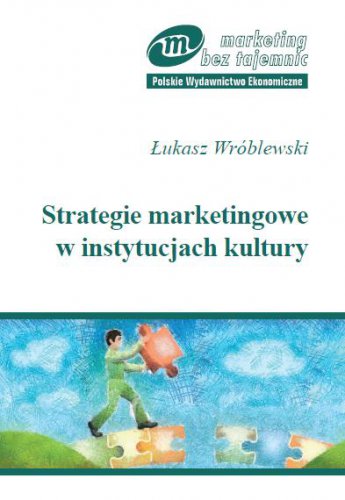Strategie marketingowe w instytucjach kultury
Publication date: 2012
Place publication: Warszawa
Publication: I
Binding: paperback
Format: 145x205
Transformation toward market economy, technological and general progress, as well as the processes of globalization and virtualization of consumption entailed significant changes in the way market-based entities operate in Poland. This also relates to institutions of high culture. The most important organizational change was their privatization, manifested, among other things, in handing over most public institutions of culture to the level of local governments. The state renounced its role as the sole manager and patron of culture and seriously reduced its contribution to financing of this type of institutions. At the same time, the share of other sectors — mainly that of local governments, but also of non-governmental/non-profit and private bodies, increased.
Institutions of culture adopted market-based orientation and faced the need to define the needs of their respective target markets and to adapt the components of marketing mix accordingly. At the same time, they had to actively stimulate such needs using some specific instruments of marketing. Also, it was equally important to develop a long-term perspective to assess the needs of the society and, on that basis, to adopt a strategic approach to marketing activities undertaken. In fact, the key area of functioning of institutions of culture, along with propagation of cultural and artistic content selected by their management, also involves respecting the will of the beholder in the process of decision making.
In his book Marketing strategies in the institutions of culture, the Author - Łukasz Wróblewski:
• presents the marketing of an institution of culture with its specificities;
• explains how marketing strategies are developed on the market of popularization of works of art;
• indicates the instruments of marketing and their place in the sphere of high culture;
• describes marketing tools based on relationships with key market players;
• discusses marketing activities and strategies applied by such institutions of culture as concert halls with philharmonic orchestras.
The book is mainly addressed to managers of culture, personnel employed in institutions of culture, cultural animators, agents, as well as independent artists who propagate their activity on their own. With the way it is structured and the areas covered, the book will be useful to students interested in acquiring knowledge in the field of marketing of culture. Recently some early and successful attempts to introduce marketing of culture as a specialization course may be observed as part of post-graduate studies in universities of economics, called “Management in culture”. This publication may also provide a valid supplement to university courses in the area of fundamentals of marketing, marketing of services, marketing of non-profit organizations or management of marketing.
SPIS TREŚCI
Wprowadzenie
CZĘŚĆ I: MARKETING INSTYTUCJI KULTURY I JEGO SPECYFIKA
Rozdział 1. Wprowadzenie do marketingu kultury
Pojęcie kultury i jej podział
Kultura wysoka i jej charakterystyka
Sztuka i jej podział
Pojęcie upowszechniania kultury
Typologia instytucji kultury
Rozdział 2. Wybrane zagadnienia rynku sztuki
Mechanizm funkcjonujący na rynku sztuki
Rynek upowszechniania dzieł sztuki i jego specyfika
Identyfikacja odbiorców na rynku sztuki
Kryteria segmentacji na rynku upowszechniania dzieł sztuki
Rozdział 3. Marketing w działalności instytucji kultury
Pojęcie marketingu kultury
Przydatność koncepcji marketingu w sferze kultury wysokiej
Model koncepcji marketingowej w instytucjach kultury wysokiej
Przedmiot i cele marketingu w instytucjach kultury wysokiej
CZĘŚĆ II: KSZTAŁTOWANIE STRATEGII MARKETINGOWEJ NA RYNKU UPOWSZECHNIANIA DZIEŁ SZTUKI
Rozdział 4. Formułowanie i wybór strategii marketingowych
Określenie misji i głównych celów strategicznych instytucji kultury
Informacja jako podstawa formułowania i wyboru strategii marketingowych
Wybór rynku docelowego
Wybór sposobów postępowania i instrumentów marketingu
Wdrożenie i kontrola strategicznych przedsięwzięć
Rozdział 5. Instrumenty marketingu i ich miejsce w sferze kultury wysokiej
Produkt a twórczość i dobra kultury
Cena a dostępność dóbr kultury
Dystrybucja i problemy upowszechniania
Promocja kultury
Personel a jakość wykonania artystycznego
Rozdział 6. Narzędzia marketingowe oparte na relacjach z głównymi uczestnikami rynku
Proces kształtowania relacji
Kształtowanie relacji z odbiorcami oferty kulturalnej
Kształtowanie relacji z donatorami
Kształtowanie relacji z pracownikami
CZĘŚĆ III: STRATEGIE MARKETINGOWE W SFERZE KULTURY NA PRZYKŁADZIE FILHARMONII
Rozdział 7. Działania strategiczne filharmonii
Misja i cele strategiczne filharmonii
Segmentacja rynku
Pozycjonowanie produktów w filharmoniach
Preferowane elementy marketingu-mix
Problemy wdrożeniowe strategii w filharmoniach
Rozdział 8. Działania marketingowe filharmonii w osiąganiu przewagi konkurencyjnej
Rodzaje konkurencji na rynku upowszechniania dzieł sztuki
Identyfikacja źródeł przewagi konkurencyjnej w filharmoniach
Jakość usług jako źródło trwałej przewagi konkurencyjnej
Wizerunek jako narzędzie osiągania długookresowej przewagi nad konkurentami
Strategie osiągania przewagi konkurencyjnej
Rozdział 9. Strategie narzędziowe stosowane przez filharmonie
Strategie produktowe
Strategie cenowe
Strategie dystrybucyjne
Strategie promocyjne
Strategie kształtowania personelu
Rozdział 10. Modele strategii marketingowych filharmonii dotyczące wyspecyfikowanych rynków docelowych
Kryteria doboru i charakterystyka analizowanych rynków
Strategia sztuki elitarnej
Strategia uwydatniania sztuki
Strategia uwrażliwiania na sztukę
Strategia popularyzacji sztuki
Słownik użytecznych terminów
Wybrane pozycje bibliograficzne
| Odbiór osobisty | 0 € |
| Kurier Inpost | 4 € |
| Kurier FedEX | 4 € |
| Inpost Paczkomaty | 4 € |
| Free delivery in Reader's Club | from 47 € |
Kultury i organizacje
Publication date: 2011
Place publication: Warszawa
Publication: III zmienione
Binding: paperback
Format: 162x237
Militarna turystyka kulturowa
Publication date: 2011
Place publication: Warszawa
Publication: I
Binding: paperback
Format: 162x237
Turystyka kulturowa
Publication date: 2008
Place publication: Warszawa
Publication: I
Binding: paperback
Wiejska turystyka kulturowa
Publication date: 2010
Place publication: Warszawa
Publication: I
Binding: paperback
Format: 162x237





